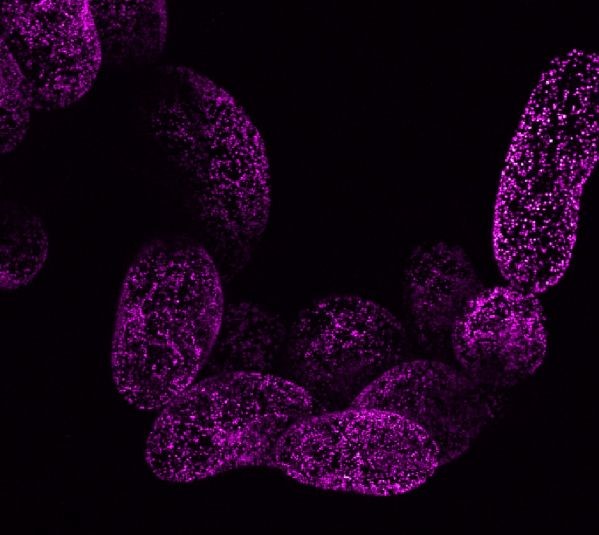Novel Living Yeast-Based Dual Biosensor for Detecting Peptide Variants
April 4, 2023
The state-of-the-art biosensor with a visible readout could have potential applications in virus detection, diagnostics, and other areas
The structural similarity and small sizes of peptide variants make their characterization challenging. Researchers from Columbia University, USA have now developed a biosensor with living yeast that expresses an enzyme to cleave a specific peptide. Differential peptide cleavage leads to color changes in yeast, allowing peptide variants with single amino acid substitutions to be detected. The system has potential for wide-ranging applications in the detection and characterization of peptide variants.
Biosensors—sensors that can detect biological samples—are powerful tools for understanding the function, composition, and structure of biochemical molecules. Biosensors are often applied for the detection of proteins and their subunits, called peptides, yielding a wide range of biomedical applications. In 2017, researchers from Columbia University in USA engineered a living yeast biosensor by rewiring pheromone-related signaling pathways used by yeast for mating. In the presence of the pheromone peptide, the G-protein coupled receptor (GPCR) could detect the peptide, triggering a cascade that would eventually activate a pigment called lycopene that gives tomatoes their red color. Thus, through a simple color change visible to the naked eye, the yeast biosensor could signal the presence of a particular peptide. However, this system lacked a peptide-cleaving catalytic enzyme called protease, the addition of which was anticipated to enhance its biosensing and discrimination abilities.
Accordingly, in a recent study made available online on 11 January 2023 and published in Volume 5 of the journal BioDesign Research on 15 March 2023, the group developed a new and improved dual version of their living yeast biosensor by incorporating co-expressed yeast proteases. The principal investigator of this study, Prof. Virginia W. Cornish, explains, “Our goal was to develop a dual biosensor. In the first part, the biosensor without the protease would detect the presence of all peptide variants. In the second part, the protease would be present. Only one variant of the protein would be cleaved by the protease so that a color change would be visible only for that specific variant. Here, we tried to develop a proof-of-concept for this sensing model.”
The development of this state-of-the-art biosensor was a long and technically challenging process. The researchers retained their original model, exploiting the mating pathways in yeast, and examined the dose–response curves of five fungal pheromone GPCRs, peptides, and proteases from Saccharomyces cerevisiae, Candida albicans, Schizosaccharomyces pombe, Schizosaccharomyces octosporus, and Schizosaccharomyces japonicus. Of these, the first two provided the most selective responses.
They then analyzed the peptides from these two species, i.e., S. cerevisiae and C. albicans, using alanine scanning—a technique that reveals how specific parts of a peptide contribute to its stability and function. Alanine scanning was performed with and without the protease. Accordingly, two peptide variants that could not be cleaved efficiently by the protease were identified: CaPep2A and CaPep2A13A. Meanwhile, their sister peptides—CaPep and CaPep13A, respectively—could be cleaved efficiently. Moreover, the color changes could be observed with the naked eye, without any need for specialized equipment.
These components were combined in a living yeast cell to develop the dual-phase biosensor. Proof-of-concept experiments revealed that the biosensor could not only detect the presence of CaPep/CaPep2A and CaPep13A/CaPep2A13A but also distinguish between them. Thus, as expected, the reintroduction of the protease enhanced the capabilities and potential applications of the original biosensor to a great extent.
According to Prof. Cornish and her team, this work is the first fundamental step towards developing a biosensor that could distinguish between a wide variety of peptides. “Synthetic biology is a step-by-step process. The framework developed in the current study can be improved through additional engineering via computational modeling and directed evolution. This will broaden the scope of biosensor’s detection capabilities,” she comments. “We could use these protease-containing biosensors in point-of-care diagnostic tools and drug testing, and even to develop a scalable communication language. The possibilities are endless,” she concludes, describing her vision for the future.
Overall, this study provides key insights into the manipulation of yeast mating components for developing synthetic biology tools. The findings are a testament to the exciting developments in the field of bioengineering and its potential to change our future.
Reference
| Authors | Tea Crnković1, Benjamin J. Bokor2, Mead E. Lockwood3, and Virginia W. Cornish1,4 |
| Title of original paper | Peptide Variant Detection by a Living Yeast Biosensor via an Epitope-Selective Protease |
| Journal | BioDesign Research |
| DOI | 10.34133/bdr.0003 |
| Affiliations | 1Department of Chemistry, Columbia University, New York, NY 10027, USA. 2Department of Biological Sciences, Columbia University, New York, NY 10027, USA. 3School of General Studies, Columbia University, New York, NY 10027, USA. 4Department of Systems Biology, Columbia University, New York, NY 10027, USA. |
Additional information for EurekAlert
| Latest article publication date | 15 March 2023 |
| Method of research | Experimental study |
| Subject of research | Cells |
| COI statement | Provisional patent application no. 63/228,577 was filed 2021 Aug naming V.W.C., T.C., and M. Fantini (Columbia University, USA) as inventors and assigned to The Trustees of Columbia University in the City of New York. V.W.C. holds equity and is Chairman of the Board and President of Celsyntec, Inc. All other authors declare no competing interests. |

Image Title: Live yeast biosensor with a visible readout for detecting variations in single peptides.
Image Caption: Owing to the co-expression of fungal proteases, the biosensor can both detect and distinguish peptides with a single amino acid substitution, which manifests as a color change in the yeast.
Image Credit: Altynai Adilbayeva from openverse
Image link: https://openverse.org/image/e4cf745b-e76e-410a-b55c-881b934bd2d3?q=biosensor
License Type: CC BY-SA 4.0
About Professor Virginia W. Cornish
Virginia
W. Cornish is the Helena Rubinstein Chair in the Department of Chemistry and a founding member of the Department of Systems Biology at Columbia University, USA. She earned her PhD from the University of California at Berkeley for her work on site-specific protein labeling and mutagenesis. She is a pioneer in the field of yeast synthetic biology, and her research focuses on the application of systems biology, synthetic biology, and DNA technology for the production of clinically useful products. She has won several accolades over her illustrious research career, including an NSF Career Award (2000) and the American Chemical Society Pfizer Award in Enzyme Chemistry (2009).



